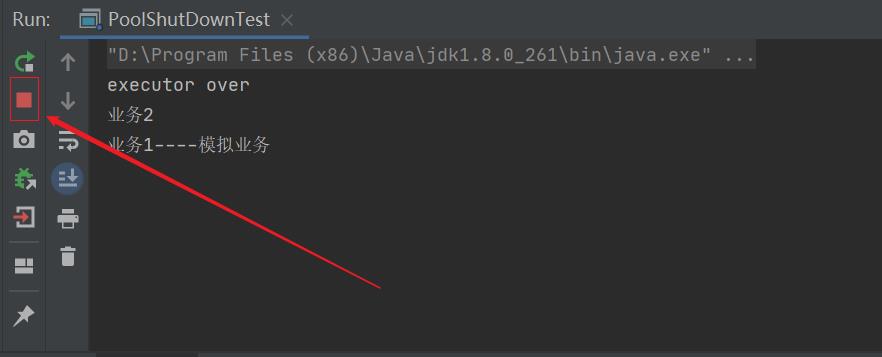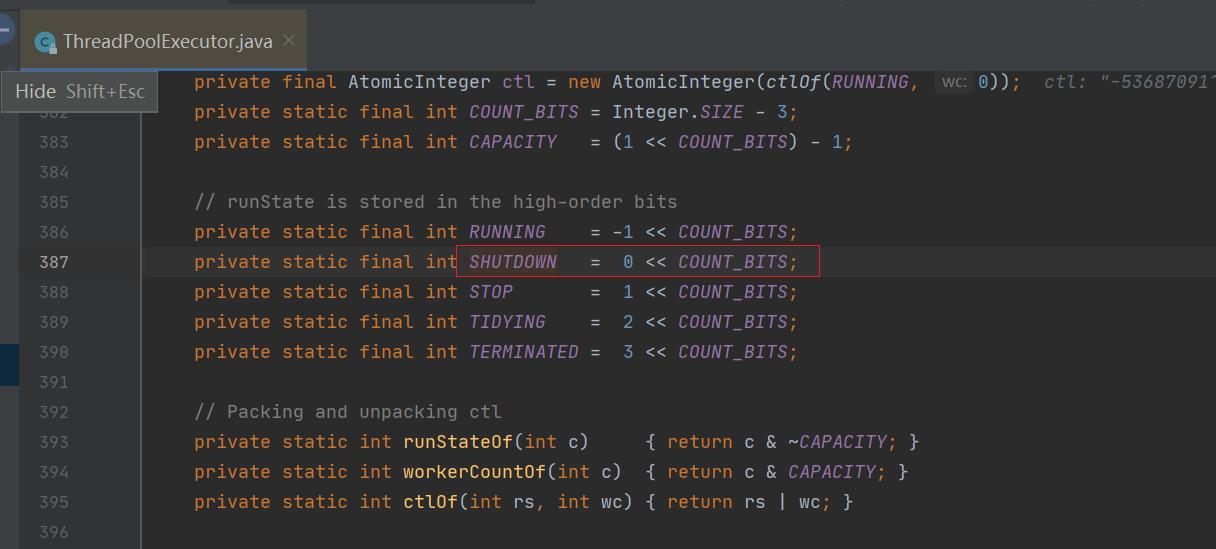Java Review - 线程池资源一直不被释放案例&源码分析
Posted 小小工匠
tags:
篇首语:本文由小常识网(cha138.com)小编为大家整理,主要介绍了Java Review - 线程池资源一直不被释放案例&源码分析相关的知识,希望对你有一定的参考价值。
文章目录
概述
在日常开发中为了便于线程的有效复用,经常会用到线程池,然而使用完线程池后如果不调用shutdown关闭线程池,则会导致线程池资源一直不被释放。
下面通过简单的例子来说明该问题。
问题复现
下面通过一个例子说明如果不调用线程池对象的shutdown方法关闭线程池,则当线程池里面的任务执行完毕并且主线程已经退出后,JVM仍然存在。
import java.util.concurrent.*;
/**
* @author 小工匠
* @version 1.0
* @description: TODO
* @date 2021/11/20 23:33
* @mark: show me the code , change the world
*/
public class PoolShutDownTest
public static void main(String[] args)
// 异步执行业务1
ThreadPoolExecutor threadPoolExecutor = new ThreadPoolExecutor(5, 10, 10,
TimeUnit.MINUTES, new LinkedBlockingDeque<>(100));
threadPoolExecutor.execute(()->
try
TimeUnit.SECONDS.sleep(3);
catch (InterruptedException e)
e.printStackTrace();
System.out.println("业务1----模拟业务");
);
// 异步执行业务2
ExecutorService executorService = Executors.newSingleThreadExecutor();
executorService.execute(()->System.out.println("业务2"));
// 业务执行完成
System.out.println("executor over");
在如上代码的主线程里面,首先 执行了异步业务, 使用线程池的一个线程执行异步操作,我们期望当主线程与异步业务执行完线程池里面的任务后整个JVM就会退出,但是执行结果却如下所示。

左上的方块说明JVM进程还没有退出 ,这是什么情况呢?修改代码代码,在方法里面添加调用线程池的shutdown方法的代码。

再次执行代码你会发现JVM已经退出了,使用ps -eaf|grep java命令查看,发现Java进程已经不存在了,这说明只有调用了线程池的shutdown方法后,线程池任务执行完毕,线程池资源才会被释放。

源码分析
下面看为何会如此?大家或许还记得守护线程与用户线程,JVM退出的条件是当前不存在用户线程,而线程池默认的ThreadFactory创建的线程是用户线程。

由如上代码可知,线程池默认的ThreadFactory创建的都是用户线程。而线程池里面的核心线程是一直存在的,如果没有任务则会被阻塞,所以线程池里面的用户线程一直存在。而shutdown方法的作用就是让这些核心线程终止.
下面简单看下shutdown的主要代码。
/**
* Initiates an orderly shutdown in which previously submitted
* tasks are executed, but no new tasks will be accepted.
* Invocation has no additional effect if already shut down.
*
* <p>This method does not wait for previously submitted tasks to
* complete execution. Use @link #awaitTermination awaitTermination
* to do that.
*
* @throws SecurityException @inheritDoc
*/
public void shutdown()
final ReentrantLock mainLock = this.mainLock;
mainLock.lock();
try
checkShutdownAccess();
// 设置线程池状态为SHUTDOWN
advanceRunState(SHUTDOWN);
// 中断所有的空闲工作线程
interruptIdleWorkers();
onShutdown(); // hook for ScheduledThreadPoolExecutor
finally
mainLock.unlock();
tryTerminate();
这里在shutdown方法里面设置了线程池的状态为SHUTDOWN,并且设置了所有Worker空闲线程(阻塞到队列的take()方法的线程)的中断标志。

/**
* Transitions runState to given target, or leaves it alone if
* already at least the given target.
*
* @param targetState the desired state, either SHUTDOWN or STOP
* (but not TIDYING or TERMINATED -- use tryTerminate for that)
*/
private void advanceRunState(int targetState)
for (;;)
int c = ctl.get();
if (runStateAtLeast(c, targetState) ||
ctl.compareAndSet(c, ctlOf(targetState, workerCountOf(c))))
break;
那么下面来看在工作线程Worker里面是不是设置了中断标志,然后它就会退出。
final void runWorker(Worker w)
.......
try
while (task != null || (task = getTask()) != null)
.......
finally
.......
private Runnable getTask()
boolean timedOut = false; // Did the last poll() time out?
for (;;)
....
// Check if queue empty only if necessary.
// 代码1
if (rs >= SHUTDOWN && (rs >= STOP || workQueue.isEmpty()))
decrementWorkerCount();
return null;
try
// 代码2
Runnable r = timed ?
workQueue.poll(keepAliveTime, TimeUnit.NANOSECONDS) :
workQueue.take();
if (r != null)
return r;
timedOut = true;
catch (InterruptedException retry)
timedOut = false;
在如上代码中,在正常情况下如果队列里面没有任务,则工作线程被阻塞到代码(2)等待从工作队列里面获取一个任务。
这时候如果调用线程池的shutdown命令(shutdown命令会中断所有工作线程),则代码(2)会抛出InterruptedException异常而返回,而这个异常被捕捉到了,所以继续执行代码(1),而执行shutdown时设置了线程池的状态为SHUTDOWN,所以getTask方法返回了null,因而runWorker方法退出循环,该工作线程就退出了。

小结
我们这里通过一个简单的使用线程池异步执行任务的案例介绍了使用完线程池后如果不调用shutdown方法,则会导致线程池的线程资源一直不会被释放,并通过源码分析了没有被释放的原因。
所以在日常开发中使用线程池后一定不要忘记调用shutdown方法关闭。
以上是关于Java Review - 线程池资源一直不被释放案例&源码分析的主要内容,如果未能解决你的问题,请参考以下文章
Java Review - 线程池使用FutureTask的小坑
Java Review - 线程池使用FutureTask的小坑
Java Review - 并发编程_ThreadPoolExecutor原理&源码剖析